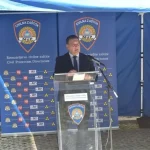March 29, 2020 — The chills hit shortly after lunch on March 9. I curled into a fetal position on the couch and threw a blanket over my shivering body.
It was the early stages of life during a pandemic. The deadly, still-mysterious and oft-dismissed coronavirus had lifted the handbrake on the global economy and was about to transform many hospitals into dens of tragedy.
I stabbed a thermometer under my tongue and checked the news: Italy was fumbling its early response. Fresh cases were trickling into Croatia via returnees.
The World Health Organization in a press conference said, “Now that the virus has a foothold in so many countries, the threat of a pandemic has become very real. But it would be the first pandemic in history that could be controlled.”
My temperature was 37.6℃ (99.7℉) — ignorable in almost all circumstances.
Two days later, the WHO declared COVID-19 a pandemic. I reached for my thermometer.
A Smorgasbord of Maladies
I developed a cadre of symptoms over the next 24 hours — some obvious, others I ignored then later added to the tally.
First came chills and body temperature fluctuations of up to 37.8℃ (or 100℉). Then diarrhea, dizziness, nausea, and an intense one-day headache, debilitating fatigue which felt like gravity doubled its force on my body.
I didn’t cough.
A doctor assured me over the phone it was a stomach bug. I agreed. She suggested I stay hydrated and call back in three days if the symptoms didn’t clear up.
While she spoke, I Googled “fever diarrhea + coronavirus”, aware of the perils of patient self-diagnosis and the “worried well.”
The less-obvious symptoms arrived one-by-one over the first 48 hours. All food became tasteless. I couldn’t smell anything. My nasal passages, sinuses, and throat felt drier than gravel.
The fatigue and lethargy became all-consuming. A trip from the restroom to the couch felt torturous. Sustained movement lasting more than 90 seconds required hours of nap time.
It rendered me useless to my wife and our three dogs, who seemed to roll their eyes at me.
I’m hypersensitive to all maladies. An odd mole has me planning my funeral. An unexpected cough has me Googling “early lung cancer symptoms” (which runs in the family).
I’m arguably not mentally equipped for an undiagnosed mild fever in the middle of a global pandemic.
Croatia had 13 confirmed coronavirus cases by the end of the day.
The Limited Testing Commandment
In Croatia and many other countries, coronavirus was — and in some places still is — treated like a game of tag: You can’t be “It” unless an already-infected person or surface touches you.
Vili Beroš, the steadfast Croatian health minister who has become an unexpected hero, has repeatedly downplayed the efficacy of widespread testing. Isolation, tracking, treatment and social distancing are key, he says.
“If we continue to fight in this way against the epidemic, we will see fewer harmful consequences,” he said at the Civil Protection Directorate’s Sunday’s press conference. “Responsible behavior is the key to success.”
The assertion runs contrary to the practices of larger and richer countries like Germany and South Korea. They credit their outcomes and low death rates to widely-available tests, social distancing and high-quality healthcare systems. Croatia arguably has only one of those three options, hence Beroš’s pleas for cooperation.
The novel coronavirus needs to stop encountering novel people.
Being a low-level recluse on a nearly-abandoned island prevents these sorts of collisions. So who would even infect me?
I could only think of a dinner four days before my first symptoms with a group of friends visiting from Zagreb. But none had visible signs of COVID-19.
Yet my fervent Googling of my symptoms pointed to anecdotal evidence that my supposed stomach bug might be something else. Researchers in China documented cases of COVID-19 with gastrointestinal symptoms, without the telltale cough.
The Mrs. and I were supposed to head home to a bucolic little island off the Dalmatian coast with an overwhelmingly geriatric population: a deep pool of diabetics, pulmonary patients, walking cardiac problems, and a slew of alcohol and tobacco-related issues.
If I was carrying some unorthodox version of COVID-19, I’d arrive on that island like a gatling gun of death, single-handedly turning it into a ghost town.
I needed to be sure I didn’t have the virus. I didn’t want to kill my neighbors. After four days of bland food, mud butt, and lethargy, I called my doctor again.
The nurse answered, and I blurted out, “It’s me. Orovic, Joseph. I need to know I don’t have the coronavirus.”
A pause. “Are you still having stomach problems?”
“Yes, and I read that might be a symptom of…” I stammered. “Look, I’m about to go to an island with a bunch of old people who will die if they get coronavirus. How can I get tested?”
***
The on-call epidemiologist picked up the phone after two tries.
“Hi, I need to know I don’t have coronavirus.”
She sniffled. “What are your symptoms?”
I rattled off my condition. She paused.
“And where did you come from? Italy? China?”
“Iž, an island off the coast, but I’m in Zadar now,” I said. “That’s why I’m calling. I don’t want to go back and infect the people there.”
“Did you spend time with anyone who came from those or other countries? Austria maybe?”
“I had dinner with some guys from Zagreb,” I said, feeling stupid as the words slipped past my lips.
The epidemiologist giggled.
“You can’t get infected unless you came from Italy or China or one of those countries,” she said with authority.
“So there’s no community transmission in Croatia?” I asked, with tales of South Korea’s “Patient 31” echoing in my head.
“No, no community transmission,” she replied. “Relax, whatever you have will go away.”
The “no community transmission” edict was central Croatia’s early response to the coronavirus. All confirmed cases were Croats returning from western Europe or were closely related to the confirmed patients.
The notion that the virus was already within the population and spreading was gently dismissed in earlier press conferences.
My doctor sent me in for blood work and samples to rule out a bacterial infection. All came back negative. I was a sick man without a diagnosis in the middle of a pandemic.
My flustered wife told me ride out the rest of my mystery ailment on the island.
Instead, I called a doctor.
“Can I go to an island if I’m not sure I don’t have the coronavirus?” I asked while the doctor read over my file.
“Did you say ‘island?’ Go! Now!” he said, suggesting 14 days of voluntary isolation and to call if my symptoms worsen. I obliged.
By this point, Croatia had 39 confirmed coronavirus patients.
Mysterious changes on a little island
The island spurred an odd fluctuation in my symptoms.
The stomach issues waned after the first week. My body temperature still rose and dipped at odd moments. My complete disinterest in food and constant lethargy caused close to six kilos (13 lbs) of weight loss.
I finally noticed our dog’s pillow smells like a burning garbage dump — so my nose was working again.
No cough.
Then on the seventh night, a tingling sensation in my chest woke me. It was as if someone rubbed toothpaste on my lungs.
I asked the same question almost every Dalmatian islander recites during a medical quagmire: What are the odds I will die before the next ferry to the mainland?
This is our reality. Medical helicopters remain an oft-promised but never-delivered pipe dream. Emergency boats sometimes take over an hour to arrive, with the trip back to the hospital lasting just as long.
The odds of surviving a life-threatening emergency like internal bleeding, heart attack or stroke are demonstrably lower here. What about chest pain during a pandemic?
I gambled on sleeping it off. Had I been on the mainland, I might have called an ambulance.
The pain subsided by the next morning and I dismissed it as a panic attack. But the temperature and lethargy lingered. Slowly, the lulls between my body temperature spikes and fatigue grew. I felt healthier more often and slept less.
On St. Joseph’s Day, ten days after my first symptoms, I declared myself “better.”
Croatia then had 105 confirmed coronavirus cases, with five patients fully recovered.
An Unwelcome Return To Abnormal
The morning of Zagreb’s earthquake, I tapped out a news brief on my phone, sent it to an editor in London then felt heat sizzle up from my chest to my jaw.
The thermometer read 37.4℃ (99.3℉) and rising. The ensuing, unexpected four-hour nap on the couch confirmed I celebrated too soon.
I was 13 days into a demoralizing stupor, my energy whittled down to slow-churning despondency. A radioactive sensation emanated from my torso. Life in the house changed.
My wife and I often took awkward, broad steps around each other like opposing gunslingers at a saloon. We avoided contact even though, ostensibly, I only had “some virus.” I wiped down faucet handles and hit light switches with my sleeve. She didn’t seem to notice.
Outside my home, life shrunk to a miniature version of itself. The government limited public gatherings to groups of five. Only private enterprises selling food, drugs, diapers, cigarettes, newspapers or gasoline remained open.
The ceremonial stop at the cafe between bursts of toil — the social lifeblood of this region — became verboten. People were told to remain in their neighborhood no matter how much the ground shook.
In Italy, nearly 1,000 people were dying every day. I watched in quiet distress as my hometown Queens, New York became the pulsating center of the United States’ coronavirus battle.
All this happened as I laid on a couch, pathetically knocked out by a middling fever and fatigue caused by a mystery virus.
The day of Zagreb’s earthquake ended with 254 confirmed COVID-19 cases in Croatia.
Two weeks after my first fever, I began recognizing my unorthodox symptoms in new reports.
New evidence suggested anosmia — a loss of sense of smell — seemed to be a symptom. Fatigue also made the list. Then finally, sitting down on the toilet more often than usual, without a dry cough, became an anecdotal sign of some alternate manifestation of the virus.
First-hand accounts from confirmed COVID-19 patients offered a picture of life with a “mild” version of the virus. Coughing and fever were the telltale signs of infection for most. But some bypassed that phase altogether and suffered other ailments.
One friend asked me a brutal question: “How many more people like you are out there?”
I couldn’t say.
I checked the newest stats. There were 495 confirmed COVID-19 infections in Croatia, and two deaths.
I’m now 20 days removed from that first shivering on the couch. I’ve had four full days of symptomless life. For all intents and purposes, I’m back to normal. I still don’t know if I had COVID-19.
This island appears to be infection-free as well. We’re hoping it stays that way.
Croatia now has 713 confirmed cases of coronavirus of 5,900 tested, with six deaths, 26 patients on respirators and 52 recovered.
Wash your hands and stay at home.










